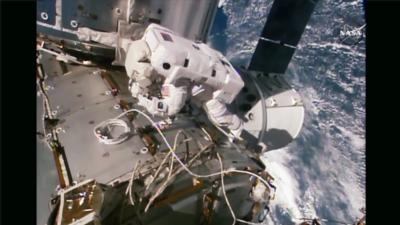Thu, Jun 27, 2024
The Old EVA Units Hold the Line 45 Years After They Were Designed - But Time's Running Out
Apparently the old NASA set the bar pretty high, now that rumors hint that RTX Collins Aerospace wants out of its contract to design them for the Artemis mission.

Reporters said that the RTX firm was in talks with NASA about dropping the contract, leaving NASA stuck with its now quite vintage Extravehicular Mobility Units spacesuits. That's bad news for the administration, since the 48-year-old equipment is a critical element in pulling off maintenance operations in orbit. The contract walkback comes at a bad time, too, with highly visible suit failures occupying the public eye. In recent weeks, NASA had to cancel a scheduled spacewalk twice, the first time citing discomfort issues, and the rescheduled walk canceled only a few minutes into its quarter-day runtime. The spacewalk ended just as quickly as it began when astronaut Tracy Dyson's suit sprung a leak, occluding the visor. That's not the first time, either. The space suits have been such a running issue that NASA's independent Aerospace Safety Advisory Panel has made it a tradition to call for their upgrade. But, development is evidently tougher than it was fifty years ago.

The contract saw $3.5 billion awarded to Collins and Axiom Space in 2022, intending to provide new space suits for extravehicular activity on the International Space Station and future lunar landings. Collings reportedly got almost $100 million of that chunk, specifically earmarked for ISS suit engineering. If they needed additional funding, they were to get extra portions from Axiom as work demanded. But one delay after another has put the contract on the backburner, leaving Collins wanting to "descope" its tasking of the Exploration Extravehicular Activity Services (xEVAS) contract. That will leave NASA in the lurch as it looks to assign Collins' work to someone else.

Axiom's efforts to make a more robust type of spacesuit fit for dusty lunar adventures may not be going so great either. Originally, the first flight-ready new xEMUs were to be ready by November 2024, but the usual delays through 2019 and beyond left the program all over the map. That's not all that surprising, since the suits were expected to be a part of a program to establish lunar landings by 2024. Across the board, things have gotten messy, as evidenced by a biting audit published in 2021. The Government Accountability Office dug deep into NASA's space suit approach, and criticized it for attempting to fund and procure two distinct, separate, and non-interchangeable space suit designs, noting that NASA had sunk more than a billion dollars into getting a next-gen suit for nothing but some non-functional window dressing. When all's said and done, today's program should have at least had two flight-ready suits, and an ISS demo suit.
More News
He Attempted To Restart The Engine Three Times. On The Third Restart Attempt, He Noticed That Flames Were Coming Out From The Right Wing Near The Fuel Cap Analysis: The pilot repor>[...]
Make Sure You NEVER Miss A New Story From Aero-News Network Do you ever feel like you never see posts from a certain person or page on Facebook or Instagram? Here’s how you c>[...]
From 2009 (YouTube Edition): Leading Air Show Performers Give Their Best Advice for Newcomers On December 6th through December 9th, the Paris Las Vegas Hotel hosted over 1,500 air >[...]
Aero Linx: NASA ASRS ASRS captures confidential reports, analyzes the resulting aviation safety data, and disseminates vital information to the aviation community. The ASRS is an i>[...]
“For our inaugural Pylon Racing Seminar in Roswell, we were thrilled to certify 60 pilots across our six closed-course pylon race classes. Not only did this year’s PRS >[...]
 NTSB Final Report: Rutan Long-EZ
NTSB Final Report: Rutan Long-EZ ANN FAQ: Turn On Post Notifications
ANN FAQ: Turn On Post Notifications Classic Aero-TV: ICAS Perspectives - Advice for New Air Show Performers
Classic Aero-TV: ICAS Perspectives - Advice for New Air Show Performers ANN's Daily Aero-Linx (06.28.25)
ANN's Daily Aero-Linx (06.28.25) Aero-News: Quote of the Day (06.28.25)
Aero-News: Quote of the Day (06.28.25)





